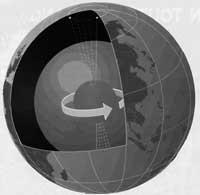The core of Earth goes faster
Our core seems to rotate faster than the upper mantle. Seismologists at Columbia University in New York have published this idea analyzing the seismic waves that cross the Earth when an earthquake occurs. The study of the earthquake in the Sandwich islands has recently been completed. Since 1967 there have been 38 earthquakes in which seismic waves have been collected in Alaska.

The core of the Earth is divided into two parts. The interior is made of heavy iron and is surrounded by cast metal. However, at present seismic waves cross the solid core faster than in 1967; approximately 0.3 seconds earlier. According to scientists, this is because the Sandwich-Alaska axis has joined the so-called “fast path” of the wave propagation core. This path would be formed by iron crystals aligned by which the waves would propagate more easily.
Thirty years ago the “fast track” was located around the axis New Zealand - Norway, but currently the speed of propagation of the waves is quite lower. In thirty years, the solid core would run 334 to the east, which means an average of 1.13/year.
The calculation of the rotation speed of the nucleus would provide very valuable information of the Earth's magnetic field, which is generated in the nucleus of the planet.





